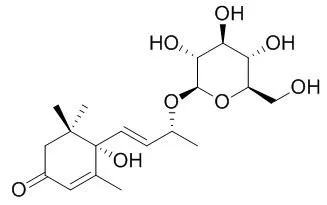| In vitro: |
| Planta Med. 2010 Jul;76(10):995-7. | | Enhancement of insulin release from the beta-cell line INS-1 by an ethanolic extract of Bauhinia variegata and its major constituent roseoside.[Pubmed: 20143296] |
Plants of the genus Bauhinia are used in several countries worldwide for the treatment of diabetes, and several related species have been shown to have hypoglycaemic effects in vivo in both normoglycaemic and alloxan- and streptozotocin-treated animal models.
METHODS AND RESULTS:
In this study, the insulin-secreting cell line INS-1 was used to examine the effects of the crude ethanolic extract of leaves of B. variegata L. var. Candida Voidt and its major metabolite (6 S,7 E,9 R)-9-hydroxymegastigma-4,7-dien-3-one-9- beta-glycopyraroside (Roseoside) on insulinotropic activity.
CONCLUSIONS:
The crude extracts and the major metabolite were shown to increase insulin secretion in a dose-dependant manner. | | J Agric Food Chem. 2002 Apr 10;50(8):2400-3. | | Antitumor activity of compounds isolated from leaves of Eriobotrya japonica.[Pubmed: 11929303] |
METHODS AND RESULTS:
In a search for possible antitumor agents from natural sources, megastigmane glycosides and polyphenolic constituents isolated from the leaves of Eriobotrya japonica (Rosaceae) were found to inhibit the 12-O-tetradecanoylphorbol-13-acetate (TPA)-induced activation of Epstein-Barr virus early antigen in Raji cells. Roseoside and procyanidin B-2 were among the active compounds found in an in vitro assay; these compounds were further assessed for antitumor activity in vivo in a two-stage carcinogenesis assay on mouse skin.
CONCLUSIONS:
Roseoside significantly delayed carcinogenesis induced by peroxynitrite (initiator) and TPA (promoter), and its potency was comparable to that of a green tea polyphenol, (-)-epigallocatechin 3-O-gallate, in the same assay. | | Life Sci. 2004 Jun 25;75(6):753-63. | | Lipid peroxidation inhibitory compounds from daylily (Hemerocallis fulva) leaves.[Pubmed: 15172183 ] | Daylilies (Hemerocallis spp.) have been used as food and in traditional medicine for thousands of years in eastern Asia.
METHODS AND RESULTS:
The leaves of the plant are used in the treatment of inflammation and jaundice. In studies of the aqueous methanol extracts of fresh Hemerocallis fulva leaves, 1',2',3',4'-tetrahydro-5'-deoxy-pinnatanine (1), pinnatanine (2), Roseoside (3), phlomuroside (4), lariciresinol (5), adenosine (6), quercetin 3-O-beta-D-glucoside (7), quercetin 3,7-O-beta-D-diglucopyranoside (8), quercetin 3-O-alpha-L-rhamnopyransol-(1-->6)-beta-D-glucopyranosol-7-O-beta-D-glucopyranoside (9), isorhamnetin-3-O-beta-D-6'-acetylglucopyranoside (10) and isorhamnetin-3-O-beta-D-6'-acetylgalactopyranoside (11) were isolated. All of these compounds were tested for their in vitro lipid peroxidation inhibitory activities.
CONCLUSIONS:
Compounds 3-5 and 7-11 were found to possess strong antioxidant properties, inhibiting lipid oxidation by 86.4, 72.7, 90.1, 79.7, 82.4, 89.3, 82.2, and 93.2%, respectively at 50 microg/mL. Compound 1 is novel and compounds 3-6 and 8-11 described here in are isolated for the first time from daylily leaves. | | Chem Pharm Bull (Tokyo). 1997 Mar;45(3):464-9. | | Medicinal foodstuffs. V. Moroheiya. (1): Absolute stereostructures of corchoionosides A, B, and C, histamine release inhibitors from the leaves of Vietnamese Corchorus olitorius L. (Tiliaceae).[Pubmed: 9085554] |
METHODS AND RESULTS:
Three new ionone glucosides named corchoionosides A, B, and C were isolated from the leaves of Corchorus olitorius, commonly called "moroheiya" in Japanese, together with seven known compounds, an ionone glucoside (6S,9R)-Roseoside, a monoterpene glucoside betulalbuside A, two flavonol glucosides astragalin and isoquercitrin, two coumarin glucosides scopolin and cichoriine, and chlorogenic acid. The absolute stereostructures of corchoionosides A, B, and C were determined by chemical and physiochemical evidence, which included the result of application of a modified Mosher's method, the CD helicity rule, and chemical correlation with (6S,9R)-Roseoside.
CONCLUSIONS:
Corchoionosides A and B and (6S,9R)-Roseoside were found to inhibit the histamine release from rat peritoneal exudate cells induced by antigen-antibody reaction. |
|






 Cell. 2018 Jan 11;172(1-2):249-261.e12. doi: 10.1016/j.cell.2017.12.019.IF=36.216(2019)
Cell. 2018 Jan 11;172(1-2):249-261.e12. doi: 10.1016/j.cell.2017.12.019.IF=36.216(2019) Cell Metab. 2020 Mar 3;31(3):534-548.e5. doi: 10.1016/j.cmet.2020.01.002.IF=22.415(2019)
Cell Metab. 2020 Mar 3;31(3):534-548.e5. doi: 10.1016/j.cmet.2020.01.002.IF=22.415(2019) Mol Cell. 2017 Nov 16;68(4):673-685.e6. doi: 10.1016/j.molcel.2017.10.022.IF=14.548(2019)
Mol Cell. 2017 Nov 16;68(4):673-685.e6. doi: 10.1016/j.molcel.2017.10.022.IF=14.548(2019)